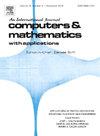具有损伤、长期记忆和磨损的准静态摩擦双边接触问题的数值分析与模拟
IF 2.9
2区 数学
Q1 MATHEMATICS, APPLIED
引用次数: 0
摘要
我们提出了一个数学模型,用于描述具有长期记忆的粘弹性体在与滑动地基摩擦接触时的平衡状态。该过程是准静态的,应力或应变过大导致的材料损伤由损伤函数捕捉。我们假设材料是不均匀的,因此会产生多种接触边界条件。接触界面分为两部分:一部分利用阿卡德定律考虑接触面的磨损。在这里,接触建模采用具有单边约束的法向顺应条件,并结合滑动版库仑干摩擦定律。在另一部分中,接触模型采用非单调条件,包括法向顺应性和次微分摩擦边界条件。模型的变分公式由一个耦合系统支配,该系统包括位移场的变分-半变分不等式、损伤场的抛物线变分不等式和磨损函数的积分方程。我们研究了一种完全离散的数值逼近方案,并对该问题的解进行了误差估计。得出了线性有限元方法的最佳误差估计值,随后进行了数值模拟,说明了模型的行为。本文章由计算机程序翻译,如有差异,请以英文原文为准。
Numerical analysis and simulation of a quasistatic frictional bilateral contact problem with damage, long-term memory and wear
We present a mathematical model describing the equilibrium of a viscoelastic body with long-term memory in frictional contact with a sliding foundation. The process is quasistatic, and material damage resulting from excessive stress or strain is captured by a damage function. We assume the material is inhomogeneous, leading to multiple contact boundary conditions. The contact interface is partitioned into two segments: One part takes into account the wear of the contact surface, utilizing Archard's law. Here, contact is modeled with a normal compliance condition with unilateral constraints, coupled with a sliding version of Coulomb's law of dry friction. In the other part, contact is modeled with a nonmonotone condition involving normal compliance and a subdifferential frictional boundary condition. Variational formulation of the model is governed by a coupled system consisting of a variational–hemivariational inequality for the displacement field, a parabolic variational inequality for the damage field and an integral equation for the wear function. We study a fully discrete scheme for numerical approximation with an error estimation of the solution to this problem. Optimal error estimates for the linear finite element method are derived, followed by numerical simulations illustrating the behavior of the model.
求助全文
通过发布文献求助,成功后即可免费获取论文全文。
去求助
来源期刊

Computers & Mathematics with Applications
工程技术-计算机:跨学科应用
CiteScore
5.10
自引率
10.30%
发文量
396
审稿时长
9.9 weeks
期刊介绍:
Computers & Mathematics with Applications provides a medium of exchange for those engaged in fields contributing to building successful simulations for science and engineering using Partial Differential Equations (PDEs).
 求助内容:
求助内容: 应助结果提醒方式:
应助结果提醒方式:


